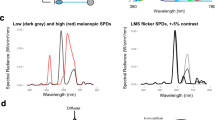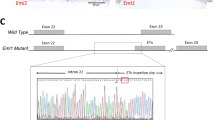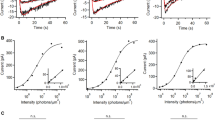Abstract
WHEN the eye is adapted to a bright yellow light, a marked loss of sensitivity for short-wavelength stimuli occurs in the first few seconds after extinction of this light. This phenomenon was first reported by Stiles1 and has been termed transient tritanopia by Mollon and Polden2. The latter authors suggest that this apparent suppression of the short-wave sensitive cones (hereafter called blue cones) during rapid dark adaptation is effected through inhibition by the recovering long- and middle-wave sensitive cone mechanisms2 (hereafter called red and green cones, respectively). In this study we attempted to localise the site of blue cone inhibition through intra-retinal recordings from the intact rhesus monkey eye. We found transient tritanopia to be absent at the receptor level but present at the b-wave level, and we conclude that transient tritanopia originates at a site between the receptors and the bipolar cells, probably at the horizontal cells, as was earlier hypothesised by Augenstein and Pugh3.
This is a preview of subscription content, access via your institution
Access options
Subscribe to this journal
Receive 51 print issues and online access
$199.00 per year
only $3.90 per issue
Buy this article
- Purchase on Springer Link
- Instant access to full article PDF
Prices may be subject to local taxes which are calculated during checkout
Similar content being viewed by others
References
Stiles, W. S. Documenta Ophth. 3, 138–163 (1949).
Mollon, J. D. & Polden, P. G. Nature 258, 421–422 (1975); 259, 570–572 (1976); Phil. Trans, R. Soc. 278, 207–240 (1977); Vision Res. 19, 435–440 (1979).
Augenstein, E. J. & Pugh, E. N. J. Physiol., Lond. 272, 247–281 (1977).
Brown, K. T. Vision Ren. 8, 633–677 (1968).
Miller, R. F. & Dowling, J. E. J. Neurophysiol. 33, 323–341 (1970).
Arden, G. B. & Brown, K. T. J. Physiol., Lond. 176, 429–461 (1965).
Norren, D. van & Padmos, P. Vision Res. 13, 1241–1254 (1973).
Wyszecki, G. & Stiles, W. S. Color Science (Wiley, New York, 1967).
Vos, J. J. & Walraven, P. L. Vision Res. 11, 799–818 (1971).
Valeton, J. M. & Norren, D. van Vision Res. (in the press).
Padmos, P. & Graf, V. Proc. XIth ISERG Symp. Doc. Ophth.. Proc. Ser., 307–314 (Junk, The Hague, 1974).
Norren, D. van & Baron, W. S. Vision Res. 17, 807–810 (1977).
Pugh, E. N. & Mollon, J. D. Vision Res. 19, 293–312 (1979).
Naka, K. I. & Rushton, W. A. H. J. Physiol., Lond. 185, 536–555 (1966a).
Baron, W. S. & Boynton, R. M. Vision Res. 14, 495–501 (1974).
Fulton, A. B. & Rushton, W. A. H. Vision Res. 18, 785–792 (1978).
Author information
Authors and Affiliations
Rights and permissions
About this article
Cite this article
VALETON, J., NORREN, D. Retinal site of transient tritanopia. Nature 280, 488–490 (1979). https://doi.org/10.1038/280488a0
Received:
Accepted:
Published:
Issue Date:
DOI: https://doi.org/10.1038/280488a0
This article is cited by
-
Cone function and cone interaction in hereditary degenerations of the central retina
Documenta Ophthalmologica (1986)
Comments
By submitting a comment you agree to abide by our Terms and Community Guidelines. If you find something abusive or that does not comply with our terms or guidelines please flag it as inappropriate.



